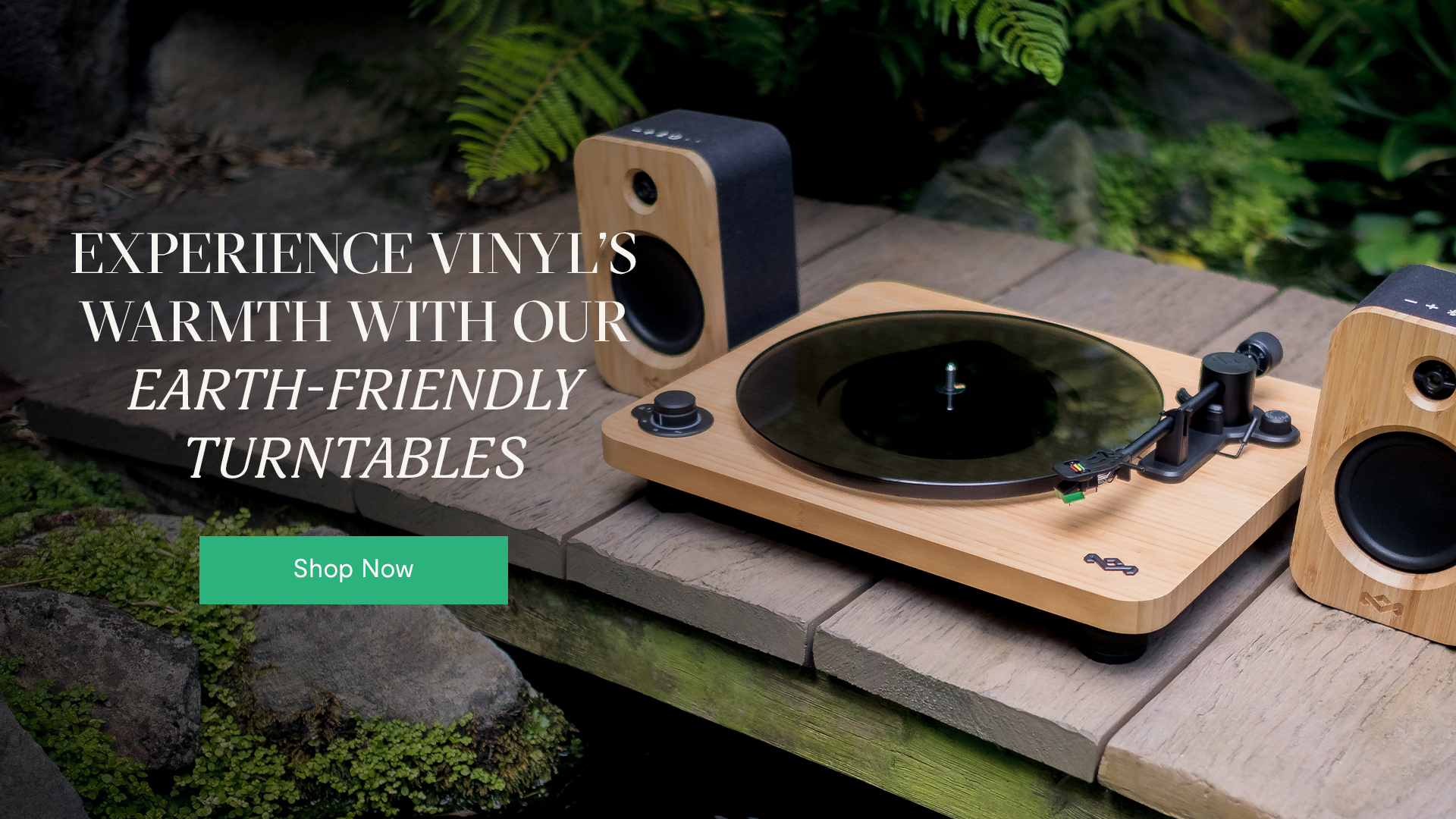7 Essential Vinyl Record Accessories
Posted by House of Marley on May 20th 2022
Listening to records for the first time opens up a whole new world for music lovers, but buying a record player and a set of speakers is just the first step in your record collecting journey. After you learn how to use and maintain a record player, you might want to start exploring the 7 essential vinyl record accessories that can take you deeper into the vinyl experience.
There are a lot of vinyl accessories out there, some of which will allow you to protect your collection, maintain your turntable and get the best sound possible and some of which … well, let’s just say you shouldn’t waste your money. But which accessories are worth your time, and what real benefits do they offer? That’s where we come in.
Ready to take your vinyl experience to the next level? Check out this list of 7 essential vinyl record accessories that every record collector should own.
Carbon Fiber Brush
If you haven’t heard it on your own turntable, you’ve probably heard it in pop culture—the subtle “crackle” from a dusty vinyl record. It’s a sound that’s become timeless—and even desirable—but too much dust can be a problem for the longevity of your records and your needle. That’s why we recommend a carbon fiber brush.
Carbon fiber brushes are lined with two rows of soft bristles that remove dust and static electricity from vinyl records. Unlike a velvet record brush, which can force particles deeper into the groove, a carbon fiber brush gently lifts dust and static without harming the record.
Cleaning your records with a carbon fiber brush will help them last longer by keeping debris from colliding against the grooves. To get the best results, place the brush over the record’s surface as it spins on the platter. After a few rotations, gently wipe the brush towards the edge of the record to remove build-up—no water or cleaning solution needed! Think of it as a 60-second insurance policy to keep your vinyl collection in pristine shape for years to come.

Record Cleaning Kit
Heading home from the record store with a handful of pre-loved vintage records is exciting, but they might need a deep cleaning before they’re ready to play. With a cleaning kit, you can make any record shine like it came fresh off the press.
Cleaning your vinyl records is the best way to make them last a lifetime or longer. Although carbon fiber brushes are great for quick dust removal, record cleaning kits are better at removing dirt, fingerprints and dreaded mold that can redner a record unplayable.
There are a ton of cleaning kits on the market, including all-in-one machines that do the job for you. These kits usually include a record cleaning solution, a microfiber cloth and a stylus brush, cost around $20 and can be found online or in your local record store.
Some vinyl enthusiasts recommend unusual DIY, or “do at your own risk,” cleaning methods, like coating records in wood glue and peeling the glue off as it starts to set—it works, but you’ll have quite a mess to deal with. Despite the advantages of methods like these, namely that you probably already have the necessary tools at home, record cleaning kits are safe, reliable and hassle-free.
Alternatively, you can purchase record cleaning fluid without investing in a full kit. If you take this route, always use a clean microfiber cloth to wipe your records dry. Dirty fabric or cloths that shed particles can redeposit dirt or scratch your records beyond repair, so be careful!
Stylus Cleaning Kit
The stylus, or needle, is the most important part of how a record player works. As the record spins it travels through the groove and produces vibrations that are converted into stereo sound. But when the stylus is covered in dust and debris, it causes distortion, skipping and permanent damage to your records.
By using a stylus cleaning kit, you can keep your stylus in pristine condition and enjoy flawless sound. Stylus cleaning kits include a small brush and a bottle of cleaning solution. For the best results, we recommend cleaning the stylus before or after you listen to a record.
Like cleaning records, there are many at-home solutions, but we advise that you play safe and use a kit designed for turntables. While some audiophiles say isopropyl alcohol works, it can weaken the bond that holds the needle in place if you aren’t careful. To create a mild stylus cleaner that’s safe for your turntable, mix equal parts of distilled water and alcohol instead.
If your records are pristine but the sound isn’t, you might need a new needle instead. Check out our previous post to learn how to replace the needle on a record player.
Record Weight
From time to time, you’ll come across a vinyl record that looks more like a cereal bowl than a flat disc. This is called “warp,” and aside from looking unsightly, it can cause your record to have a wobbly sound, often referred to as “flutter” and “wow.”
There are two main causes of warped records, and they both have to do with improper storage. Storing your records at an angle or stacked on top of each other over long periods of time is a major cause, as is exposing them to excessive heat (over 100 degrees Fahrenheit) and sunlight. However, warping can also occur during manufacturing or distribution, though this is more common in brand new records than pre-loved vintage ones.
If you notice any warped records in your collection, use a record weight. Record weights, or clamps, are a temporary fix that keeps warped records flat while they spin. Audiophiles also say that record weights improve bass and eliminate resonance by coupling the record to the platter.
Record weights are affordable and convenient, however, they won’t fix severely warped records that have the ‘deep-dish pizza’ look. Those might be fixable if exposed to heat and flattened, but it’s never a guarantee. And just because you notice skipping doesn’t mean your records are warped. Learning how to fix a skipping record can help you troubleshoot what else might be causing the problem.
Record Storage
With warped records in mind, investing in record storage is essential for keeping your records in good condition. And you don’t need to set a ton of space aside or a big budget either. There are plenty of ways to store your vinyl, from classic wood crates to built-in shelves.
Your record collection is a fun investment, so why wouldn’t you protect it? As mentioned above, pressure at the wrong angles and heat can cause your records to develop severe playback issues. That’s why it’s imperative that you place your records upright and packed relatively tightly in a climate-controlled space.
For beginners with smaller collections or limited space, we recommend the classic wood crate. Not only is it practical, but wood is a sturdy material with a natural look that matches any home. House of Marley knows a thing or two about creating a natural aesthetic—our Stir It Up Turntables are built with 100% natural bamboo.
Replacement Inner Sleeves
You’ve probably come home from the record store with a vintage LP—tattered album cover and all. While it's a cool experience, vintage records tend to have yellow or torn inner sleeves from years of use. If your inner sleeves are in rough shape, you should consider replacing them with something better.
Inner sleeves keep your vinyl records safe while they’re stored in the jacket. Although paper sleeves are the norm, they’re known for collecting dust, scratching records and causing static—a recipe for poor sound. Instead, we recommend non-scratching, anti-static sleeves made of rice paper or high-density polyethylene.
Upgrading your inner sleeves will provide better protection against dust while keeping your records static-free at all times. Paired with a carbon fiber brush, you’ll be able to care for your record collection and get the best sound possible.
Slipmats
Slipmats give your records a safe surface while they’re laying on the platter. All turntables come with a slipmat, but there are other styles to choose from that offer different advantages.
Felt is the most common slipmat material (and you can find those slipmats with fun designs that match your personality), but cork and rubber are popular alternatives due to their low resonance and anti-static qualities. Turntables that offer acrylic platters can be used without a slipmat. Glass, for example, has benefits that are similar to what cork and rubber can offer.
So, which material is the best? Like almost every vinyl record topic, it comes down to personal preference. Your vinyl experience is what you want it to be, and there aren’t any wrong answers. Have fun and do what sounds good!
Enjoy the Vinyl Warmth
With these vinyl record accessories, you’ll have everything you need to enjoy your record collection and keep them in pristine condition for years to come. Choose House of Marley Stir It Up Turntables for a premium vinyl experience like no other. Additionally, explore our exclusive turntable bundles at House of Marley, where we pair our top-quality turntables with perfectly matched speakers.













